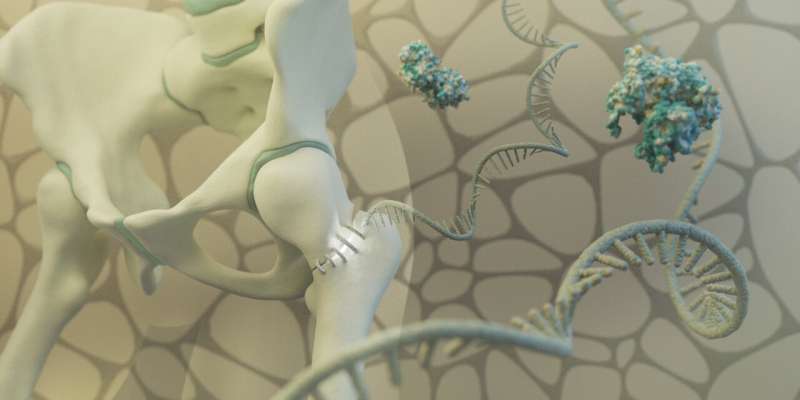This article has been reviewed according to Science X's editorial process and policies. Editors have highlighted the following attributes while ensuring the content's credibility:
fact-checked
peer-reviewed publication
trusted source
proofread
Ancient viral elements in RNA kickstart bone repair

Around half of the human genome is composed of DNA fragments originating from ancient viruses. These "transposable elements" (TEs) are now known to play various roles in modulating gene expression and disease development. Now, an international team led by KAUST researchers has shown that a common transposable element called LINE-1 RNA plays a positive role in triggering bone repair, with potential applications in treating osteoporosis and many other diseases.
The paper is published in The EMBO Journal.
"Once termed 'junk DNA,' scientists thought that TEs were irrelevant or even harmful," says research scientist Arianna Mangiavacchi at KAUST, who worked on the study with faculty member Valerio Orlando and co-workers. "However, many positive roles for TEs are now being uncovered, and our work on bone repair adds new knowledge to this field."
Mangiavacchi and Orlando's research focuses on aging processes and how the body responds to environmental stressors over time. Scientists know TE levels increase as people age, but their roles in tissue health are poorly understood. Previous work by Mangiavacchi and co-workers suggested a link between LINE-1 RNA activity and bone health, so the team sought to verify the mechanisms at play.
Firstly, the team conducted sequencing experiments on mice with bone fractures and found that TEs, especially LINE-1 RNA, were upregulated for a short period of time following fracture.
"Further investigations showed that LINE-1 RNA activated a program of carefully regulated inflammation, which in turn induced a specific signaling pathway to repair the fracture," says Mangiavacchi.
The researchers then examined TEs in bone cells (osteoblasts) taken from postmenopausal women with osteoporosis and a healthy control group. TEs, particularly LINEs, were strongly upregulated in healthy femurs with high bone density, while those with lower bone density and osteoporosis exhibited low LINE expression.
"We added synthetic LINE-1 RNA to these cell cultures, and the results were surprisingly clear," says Mangiavacchi. "Osteoblasts treated with LINE-1 RNA displayed a distinctive phenotype where the bone matrix formed abundantly and quickly. Crucially, cells derived from osteoporotic patients were rescued by the LINE-1 RNA treatment."
"It appears the human body co-opted viral TEs to trigger an inflammatory response to damage, thus kickstarting the innate immune system to repair bone and tissues. The so-called 'dark side' of TEs was acquired deliberately into our genome, enabling us to adapt and be more resilient," says Orlando.
This discovery is protected by two patents, one licensed to biotech company Altos Labs in California, and the other to the start-up company RepeatEra, founded by Orlando and Mangiavacchi, to take their pro-regenerative therapy to clinical trials.
"We believe this mechanism is not exclusive to bone, and so therapies based on synthetic LINE-1 RNA could have many applications, from corneal repair to skin-protective cosmetics," says Mangiavacchi. "We are excited to expand on these results and understand how TEs influence other cell types."
More information: Arianna Mangiavacchi et al, LINE-1 RNA triggers matrix formation in bone cells via a PKR-mediated inflammatory response, The EMBO Journal (2024). DOI: 10.1038/s44318-024-00143-z
Journal information: EMBO Journal



















